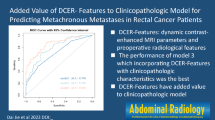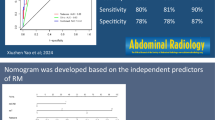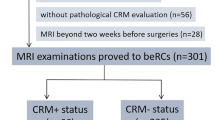Abstract
Purpose
At present, there are few effective method to predict metachronous liver metastasis (MLM) from rectal cancer. We aim to investigate the efficacy of radiomics based on multiparametric MRI of first diagnosed rectal cancer in predicting MLM from rectal cancer.
Methods
From 301 consecutive histopathologically confirmed rectal cancer patients, 130 patients who have no distant metastasis detected at the time of diagnosis were enrolled and divided into MLM group (n = 49) and non-MLM group (n = 81) according to whether liver metastasis be detected later than 6 month after the first diagnosis of rectal cancer within 3 years’ follow-up. The 130 patients were divided into a training set (n = 91) and a testing set (n = 39) at a ratio of 7:3 by stratified sampling using SPSS 24.0 software. The DWI model, HD T2WI model, and DWI + HD T2WI model were constructed respectively. The best performing model was selected and combined with the screened clinical features (including non-radiomics MRI features) to construct a fusion model. The testing set was used to evaluate the performance of the models, and the area under the curve (AUC) of receiver operating characteristics (ROC) was calculated for both the training set and the testing set.
Results
The AUC of the DWI + HD T2WI model in the testing set was higher than that of the DWI or the HD T2 model alone with statistically significance (P < 0.05). The screened clinical features were extramural vascular invasion (EMVI), T and N stages in MRI (mrT, mrN), and the distance from the lower edge of the tumor to the anal verge. The AUC of the fusion model in the testing set was 0.911. Decision curves and nomogram also showed that the fusion model had excellent clinical performance.
Conclusion
The fusion model of primary rectal cancer MRI based radiomics combing clinical features can effectively predict MLM from rectal cancer, which may assist clinicians in formulating individualized monitoring and treatment plans.
Graphical abstract







Similar content being viewed by others
References
Sung H, Ferlay J, Siegel RL, etal. Global Cancer Statistics 2020: GLOBOCAN Estimates of Incidence and Mortality Worldwide for 36 Cancers in 185 Countries. CA Cancer J Clin. 2021;71(3):209–249. https://doi.org/10.3322/caac.21660.
Chinese College of Surgeons, Section of Gastrointestinal Surgery, et al. [China guideline for diagnosis and comprehensive treatment of colorectal liver metastases (version 2020)]. Zhonghua Wei Chang Wai Ke Za Zhi. 2021 25;24(1):1–13. https://doi.org/10.3760/cma.j.cn.441530-20201225-00680.
Siegel RL, Miller KD, Goding Sauer A, et al. Colorectal cancer statistics, 2020. CA Cancer J Clin. 2020;70(3):145–164. https://doi.org/10.3322/caac.21601.
Beets-Tan RGH, Lambregts DMJ, Maas M, et al. Magnetic resonance imaging for clinical management of rectal cancer: updated recommendations from the 2016 European Society of Gastrointestinal and Abdominal Radiology (ESGAR) consensus meeting. Eur Radiol. 2018;28(4):1465–1475. https://doi.org/10.1007/s00330-017- 5026-2.
Nougaret S, Rousset P, Gormly K, et al. Structured and shared MRI staging lexicon and report of rectal cancer: A consensus proposal by the French Radiology Group (GRERCAR) and Surgical Group (GRECCAR) for rectal cancer. Diagn Interv Imaging. 2022;103(3):127–141. https://doi.org/10.1016/j.diii.2021.08.003.
Lambin P, Rios-Velazquez E, Leijenaar R, et al. Radiomics: extracting more information from medical images using advanced feature analysis. Eur J Cancer,2012,48:441–446. https://doi.org/10.1016/j.ejca.2011.11.036.
Kumar V, Gu Y, Basu S, Berglund A, et al. Radiomics: the process and the challenges. Magn Reson Imaging. 2012, 30:1234–1248. https://doi.org/10.1016/j.mri.2012.06.010.
Aerts HJ, Velazquez ER, Leijenaar RT, et al. Decoding tumour phenotype by noninvasive imaging using a quantitative radiomics approach. Nat Commun. 2014 3;5:4006. https://doi.org/10.1038/ncomms5006.
Liang M, Cai Z, Zhang H, et al. Machine Learning-based Analysis of Rectal Cancer MRI Radiomics for Prediction of Metachronous Liver Metastasis. Acad Radiol. 2019;26(11):1495–1504. https://doi.org/10.1016/j.acra.2018.12.019.
Li Y, Eresen A, Shangguan J, et al. Establishment of a new non-invasive imaging prediction model for liver metastasis in colon cancer. Am J Cancer Res. 2019;9(11):2482–2492.
Lee S, Choe EK, Kim SY, Kim HS, Park KJ, Kim D. Liver imaging features by convolutional neural network to predict the metachronous liver metastasis in stage I-III colorectal cancer patients based on preoperative abdominal CT scan. BMC Bioinformatics. 2020;21(Suppl 13):382. Published 2020 Sep 17. doi:https://doi.org/10.1186/s12859-020-03686-0.
Xue K, Liu L, Liu Y, Guo Y, Zhu Y, Zhang M. Radiomics model based on multi-sequence MR images for predicting preoperative immunoscore in rectal cancer. Radiol Med. 2022. https://doi.org/10.1007/s11547-022-01507-3.
Wang D, Zhuang Z, Wu S, et al. A Dual-Energy CT Radiomics of the Regional Largest Short-Axis Lymph Node Can Improve the Prediction of Lymph Node Metastasis in Patients With Rectal Cancer. Front Oncol. 2022;12:846840. https://doi.org/10.3389/fonc.2022.846840.
Beckers RCJ, Lambregts DMJ, Schnerr RS,et al. Whole liver CT texture analysis to predict the development of colorectal liver metastases-A multicentre study. Eur J Radiol. 2017;92:64–71. https://doi.org/10.1016/j.ejrad.2017.04.019.
Beckers RCJ, Beets-Tan RGH, Schnerr RS, et al. Whole-volume vs. segmental CT texture analysis of the liver to assess metachronous colorectal liver metastases. Abdom Radiol (NY). 2017;42(11):2639–2645. https://doi.org/10.1007/s00261-017-1190-8.
Beckers RCJ, Trebeschi S, Maas M, et al. CT texture analysis in colorectal liver metastases and the surrounding liver parenchyma and its potential as an imaging biomarker of disease aggressiveness, response and survival. Eur J Radiol. 2018;102:15–21. https://doi.org/10.1016/j.ejrad.2018.02.031.
Lee SJ, Zea R, Kim DH, Lubner MG, Deming DA, Pickhardt PJ. CT texture features of liver parenchyma forpredicting development of metastatic disease and overall survival in patients with colorectal cancer. Eur Radiol. 2018;28(4):1520–1528. https://doi.org/10.1007/s00330-017-5111-6.
Yushkevich PA, Piven J, Hazlett HC, et al. User-guided 3D active contour segmentation of anatomical structures: significantly improved efficiency and reliability. Neuroimage. 2006;31(3):1116–28. https://doi.org/10.1016/j.neuroimage.2006.01.015.
PyRadiomics community. Radiomic features.https://pyradiomics.readthedocs.io/en/latest/features.html (2016).
van Griethuysen JJM, Fedorov A, Parmar C, et al. Computational Radiomics System to Decode the Radiographic Phenotype. Cancer Res. 2017;77(21):e104–e107. https://doi.org/10.1158/0008-5472.CAN-17-0339.
Vogel JD, Felder SI, Bhama AR, et al. The American Society of Colon and Rectal Surgeons Clinical Practice Guidelines for the Management of Colon Cancer. Dis Colon Rectum. 2022;65(2):148-177. https://doi.org/10.1097/DCR.0000000000002323.
Glynne-Jones R, Wyrwicz L, Tiret E, et al, ESMO Guidelines Committee. Rectal cancer: ESMO Clinical Practice Guidelines for diagnosis, treatment and follow-up. Ann Oncol. 2018;29(Suppl 4):iv263. https://doi.org/10.1093/annonc/mdy161.
DeLong ER, DeLong DM, Clarke-Pearson DL. Comparing the areas under two or more correlated receiver operating characteristic curves: a nonparametric approach. Biometrics. 1988;44(3):837–45.
Fernandes MC, Gollub MJ, Brown G. The importance of MRI for rectal cancer evaluation. Surg Oncol. 2022:101739. https://doi.org/10.1016/j.suronc.2022.101739.
Li Y, Gong J, Shen X, et al. Assessment of Primary Colorectal Cancer CT Radiomics to Predict Metachronous Liver Metastasis. Front Oncol. 2022;12:861892. https://doi.org/10.3389/fonc.2022.861892.
Taghavi M, Trebeschi S, Simões R, Meek DB, Beckers R, Lambregts D, et al. Machine Learning-Based Analysis of CT Radiomics Model for Prediction of Colorectal Metachronous Liver Metastases. Abdominal Radiol (New York) (2021) 46(1):249–56. https://doi.org/10.1007/s00261-020-02624-1.
Leake I. Colorectal cancer. Understanding the routes of metastasis in colorectal cancer. Nat Rev Gastroenterol Hepatol. 2014;11(5):270. https://doi.org/10.1038/nrgastro.2014.60.
Tacconi C, Correale C, Gandelli A, et al. Vascular endothelial growth factor C disrupts the endothelial lymphatic barrier to promote colorectal cancer invasion. Gastroenterology. 2015;148(7):1438–51.e8. https://doi.org/10.1053/j.gastro.2015.03.005.
Lord AC, DʼSouza N, Shaw A, et al. MRI-Diagnosed Tumour Deposits and EMVI Status Have Superior Prognostic Accuracy to Current Clinical TNM Staging in Rectal Cancer. Ann Surg. 2020. https://doi.org/10.1097/SLA.0000000000004499.
Tan JJ, Carten RV, Babiker A, Abulafi M, Lord AC, Brown G. Prognostic Importance of MRI-Detected Extramural Venous Invasion in Rectal Cancer: A Literature Review and Systematic Meta-Analysis. Int J Radiat Oncol Biol Phys. 2021;111(2):385–394. https://doi.org/10.1016/j.ijrobp.2021.05.136.
Siddiqui MRS, Simillis C, Hunter C, et al. A meta-analysis comparing the risk of metastases in patients with rectal cancer and MRI-detected extramural vascular invasion (mrEMVI) vs mrEMVI-negative cases. Br J Cancer. 2017;116(12):1513–1519. https://doi.org/10.1038/bjc.2017.99.
Kim YC, Kim JK, Kim MJ, Lee JH, Kim YB, Shin SJ. Feasibility of mesorectal vascular invasion in predicting early distant metastasis in patients with stage T3 rectal cancer based on rectal MRI. Eur Radiol. 2016;26(2):297–305. https://doi.org/10.1007/s00330-015-3837-6.
Iizasa T, Suzuki M, Yoshida S, et al. Prediction of prognosis and surgical indications for pulmonary metastasectomy from colorectal cancer. Ann Thorac Surg. 2006;82(1):254–260. https://doi.org/10.1016/j.athoracsur.2006.02.027.
Li R, Zhang C, Du K, et al. Analysis of Prognostic Factors of Rectal Cancer and Construction of a Prognostic Prediction Model Based on Bayesian Network. Front Public Health. 2022;10:842970. https://doi.org/10.3389/fpubh.2022.842970.
Shen D, Wang X, Wang H, et al. Current Surveillance After Treatment is Not Sufficient for Patients With Rectal Cancer With Negative Baseline CEA. J Natl Compr Canc Netw. 2022:1–10. https://doi.org/10.6004/jnccn.2021.7101.
Xiao C, Zhou M, Yang X, et al. Accurate Prediction of Metachronous Liver Metastasis in Stage I-III Colorectal Cancer Patients Using Deep Learning With Digital Pathological Images. Front Oncol. 2022;12:844067. https://doi.org/10.3389/fonc.2022.844067.
Wang L, Lv P, Xue Z, et al. Novel CT based clinical nomogram comparable to radiomics model for identification of occult peritoneal metastasis in advanced gastric cancer. Eur J Surg Oncol. 2022. https://doi.org/10.1016/j.ejso.2022.06.034.
Duan C, Zhou X, Wang J, et al. A radiomics nomogram for predicting the meningioma grade based on enhanced T1WI images. Br J Radiol. 2022:20220141. https://doi.org/10.1259/bjr.20220141.
Liu X, Elbanan MG, Luna A, et al. Radiomics in Abdominopelvic Solid-Organ Oncologic Imaging: Current Status. AJR Am J Roentgenol. 2022. https://doi.org/10.2214/AJR.22.27695.
Naseri H, Skamene S, Tolba M, et al. Radiomics-based machine learning models to distinguish between metastatic and healthy bone using lesion-center-based geometric regions of interest. Sci Rep. 2022;12(1):9866. https://doi.org/10.1038/s41598-022-13379-8.
Nardone V, Reginelli A, Grassi R, et al. Ability of Delta Radiomics to Predict a Complete Pathological Response in Patients with Loco-Regional Rectal Cancer Addressed to Neoadjuvant Chemo-Radiation and Surgery. Cancers (Basel). 2022;14(12) https://doi.org/10.3390/cancers14123004.
Hou M, Zhou L, Sun J. Deep-learning-based 3D super-resolution MRI radiomics model: superior predictive performance in preoperative T-staging of rectal cancer. Eur Radiol. 2022. https://doi.org/10.1007/s00330-022-08952-8.
Bonomo P, Socarras Fernandez J, Thorwarth D, et al. Simulation CT-based radiomics for prediction of response after neoadjuvant chemo-radiotherapy in patients with locally advanced rectal cancer. Radiat Oncol. 2022;17(1):84. https://doi.org/10.1186/s13014-022-02053-y.
Funding
This work was supported by Key Research and Development Plan Guidance Project of Cangzhou City (Grant No. 213106017).
Author information
Authors and Affiliations
Contributions
All authors contributed to the study conception and design. Material preparation, data collection and analysis were performed by Z-fL. The first draft of the manuscript was written by Z-fL and all authors commented on previous versions of the manuscript. The manuscript was modified and finalized by L-qK. All authors have approved the final manuscript.
Corresponding author
Ethics declarations
Conflict of interest
All authors report there are no competing interests to declare. The authors have no relevant financial or non-financial interests to disclose.
Ethical approval
The study complied with the standards of the declaration of the Helsinki and current ethical guidelines, and was approved by ethics review committee at Cangzhou Central Hospital.
Informed consent
Informed consent was obtained from all patients.
Additional information
Publisher's Note
Springer Nature remains neutral with regard to jurisdictional claims in published maps and institutional affiliations.
Rights and permissions
Springer Nature or its licensor (e.g. a society or other partner) holds exclusive rights to this article under a publishing agreement with the author(s) or other rightsholder(s); author self-archiving of the accepted manuscript version of this article is solely governed by the terms of such publishing agreement and applicable law.
About this article
Cite this article
Li, Zf., Kang, Lq., Liu, Fh. et al. Radiomics based on preoperative rectal cancer MRI to predict the metachronous liver metastasis. Abdom Radiol 48, 833–843 (2023). https://doi.org/10.1007/s00261-022-03773-1
Received:
Revised:
Accepted:
Published:
Issue Date:
DOI: https://doi.org/10.1007/s00261-022-03773-1




